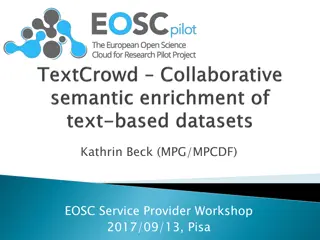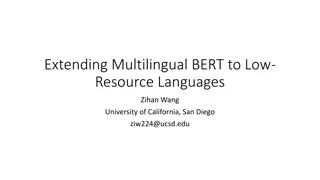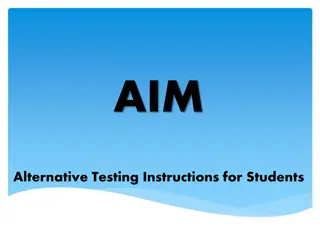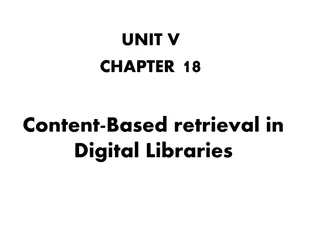Effective Use of RE-AIM in Implementation Research
Explore the origins, elements, and case uses of the RE-AIM framework. Learn how to address common misconceptions, its evolution, and related resources. Follow Dr. Marcia G. Ory's professional journey and the mission of the Center for Community Health and Aging. Discover the RE-AIM origin story, hypo
1 views • 49 slides
Understanding Investigations in Science
Investigating in science involves various approaches beyond fair tests, such as pattern-seeking, exploring, and modeling. Not all scientists rely on fair tests, as observational methods are also commonly used. The scientific method consists of steps like stating the aim, observing, forming hypothese
1 views • 20 slides
The Access and Inclusion Model (AIM) - Supporting Inclusive Early Learning
The Access and Inclusion Model (AIM) provides supports for children and staff in Early Learning and Care settings to create a more inclusive environment regardless of ability. Founded in 2016 by the DCEDIY, AIM offers Universal and Targeted supports to empower preschool providers and focus on the ne
3 views • 13 slides
Comprehensive Guide to iCn3D Structure Viewer Features
Explore the diverse functionalities of iCn3D Structure Viewer through this detailed tutorial by Jiyao Wang, emphasizing H-Bonds, Interactions, Electrostatic Potential, Alternate Mutant, Wild Type, VAST+ Alignment, Multiple Chain Alignment, and more. Learn how to utilize different views, graphs, tabl
0 views • 17 slides
Identifiers and Servers for Data Visualization and Exchange
Craig L. Zirbel at Bowling Green State University offers services through the BGSU RNA group for analyzing and annotating RNA 3D structures. They focus on Watson-Crick and non-Watson-Crick base pairs, base stacking, interactions, and motif searches. The group's ultimate goal is to predict 3D motifs
0 views • 31 slides
Enhancing Understanding of MPNS Items Through Annotations and Example Responses
Gain deeper insights into each MPNS item through detailed annotations and example responses, shedding light on potential reasons for varied participant responses. These resources are ideal for training purposes to improve comprehension of the MPNS-SF and MPNS-R scales. Contact us for editable versio
0 views • 37 slides
Managing Belief Annotations in Databases: A Modal Logic Approach
Explore the concept of belief databases that enable data curation based on modal and default logic in a relational model. The work discusses managing inconsistent views in community databases and presents a motivating application scenario to illustrate the challenges and solutions in handling belief
0 views • 34 slides
Healthy Breakfast in a Jar Designs for On-the-Go Nutrition
In this project, students are tasked with designing and creating four different Breakfast in a Jar options that promote healthy eating. They need to consider ingredients that provide energy, protein, fiber, vitamins, and minerals. The designs should be colorful, incorporate a variety of textures, an
0 views • 11 slides
Mastering APA Style: Annotated Bibliographies & Presentations
Exploring the world of APA style through annotated bibliographies and PowerPoint presentations. Learn how to combine bibliographic references with annotations, summarize sources, analyze their relevance, and reflect on their impact. Enhance your research and writing skills with these essential tools
0 views • 23 slides
Enhancing Biological Context Annotation for AOPs: A Comprehensive Approach
Manual creation and homogenization of biological context annotations for AOPs and key events help in interlinking different AOPs to understand possible connections between pathways. The process involves compiling AOPs for various organisms, including humans and model species, annotating key events w
0 views • 13 slides
Clinical Judgement Test: Research Question Relevance and Study Design Assessment
This document presents a Clinical Judgement Test focusing on the relevance of a research question and the appropriateness of the study design. Candidates are evaluated on their critical review skills and ability to assess both strengths and weaknesses of the research methodology employed. The test a
0 views • 12 slides
Overview of Spring Boot Tutorials and Essential Scrum Practices
This content highlights various units in the Spring Boot tutorials by Javabrains and Essential Scrum practices outlined in the book "Essential Scrum" by Kenneth S. Rubin. It covers topics such as Spring Boot application development, Spring MVC, Spring Data JPA, deployment, and monitoring. The tutori
0 views • 36 slides
Cyclonic Flow Analysis in Atmospheric Dynamics Study
The figures presented in this study showcase cross-sections and composite sections of cyclonic flow induced by upper-level potential vorticity (PV) anomalies. Various parameters such as potential temperature, wind velocity, geopotential height, and relative humidity are analyzed to understand the st
0 views • 9 slides
Artistic Development in GCSE Art & Design Exam
Understand the importance of investigating artists' work, exploring ideas, and experimenting with different materials in GCSE Art & Design exam. Embrace the assessment objectives to develop a visual story and showcase your journey through annotations and practical work.
0 views • 8 slides
Analysis of Affymetrix Arrays Using RMA and ANOVA Model
Downloaded Affymetrix arrays were loaded into R using ReadAffy(), followed by fitting the oneway ANOVA model to the RMA processed data and adjusting p-values for false discovery rate. Significant genes were identified and their annotations searched using AmiGO.
0 views • 11 slides
Workshop on EOSC Service Provider Challenges and Solutions in Pisa
Workshop held in Pisa addressing challenges and solutions for EOSC service providers in the realm of Social Sciences, Humanities, and Cultural Heritage. Discussions revolved around fragmented research landscapes, text-based datasets, linguistic annotations, and machine learning models for NLP tools.
0 views • 17 slides
Creating a Crankshaft in SolidWorks: Step-by-Step Guide
Learn how to design and assemble a crankshaft in SolidWorks using the sweep feature, sketches for profile and path, and adding components like a conrod and slider. Follow along with detailed visual aids and audio annotations.
0 views • 6 slides
Extending Multilingual BERT to Low-Resource Languages
This study focuses on extending Multilingual BERT to low-resource languages through cross-lingual zero-shot transfer. It addresses the challenges of limited annotations and the absence of language models for low-resource languages. By proposing methods for knowledge transfer and vocabulary accommoda
0 views • 21 slides
Denoising-Guided Deep Reinforcement Learning for Social Recommendation
This research introduces a Denoising-Guided Deep Reinforcement Learning framework, DRL4So, for enhancing social recommendation systems. By automatically masking noise from social friends to improve recommendation performance, this framework focuses on maximizing the positive utility of social denois
0 views • 15 slides
ROTC Form 48 Preparation Guidelines
Comprehensive instructions for completing Form 48 in ROTC, including timelines, signing procedures, academic class requirements, and course annotations. Follow these guidelines to outline your academic classes until graduation effectively. Ensure proper signatures and reviews for accurate completion
0 views • 8 slides
Mastering Newsela: Tips for Success in Reading and Grading Rubric
Enhance your Newsela reading skills by following grading rubrics and guidelines provided. Learn how to read within your current Lexile range, answer comprehension questions, create meaningful annotations, and craft a well-supported write response. Utilize highlighter colors effectively, challenge yo
0 views • 9 slides
Overview of Java Programming Language
Java is a versatile and powerful programming language created by James Gosling and others at Sun Microsystems in the 1990s. It aims for portability, reliability, safety, simplicity, and efficiency. With a strong focus on object-oriented programming, Java has evolved over the years with a rich histor
0 views • 33 slides
Harmonizing DICOM SR and AIM for Enhanced Clinical Annotation Workflow
Mechanisms like DICOM SR and AIM offer ways to encode annotations in medical imaging, each with unique benefits. The goal is to establish bi-directional mapping for interoperability between DICOM SR-based systems and AIM workstations, particularly for tasks like tumor measurements and clinical repor
0 views • 15 slides
Understanding AIM-ECD: An Innovative Tool for Early Childhood Development Measurement
AIM-ECD is a comprehensive tool designed for measuring early childhood development, consisting of Child Direct Assessment (DA) and Caregiver Report (CR). It covers key domains like Early Literacy, Early Numeracy, Executive Functioning, and Social-Emotional skills. Implemented in various countries, A
0 views • 11 slides
Alternative Testing Instructions for Students using AIM System
Students using the Accessible Information Management (AIM) online system for scheduling quizzes and exams are guided on how to request accommodations, communicate with instructors, schedule exams, and manage exam requests. Instructions include accessing AIM, submitting exam forms, scheduling exams,
0 views • 7 slides
Step-By-Step Instructions for Faculty Using the AIM Portal
General overview of the process for faculty members using the Accessible Information Management (AIM) portal at their Student Access Center (SAC). Key points include applying and registering with SAC, requesting letters of accommodation, scheduling exams, completing Alternative Testing Agreements, a
0 views • 13 slides
The FAIR Principles for Data Management and Stewardship
Embrace the FAIR principles - Findable, Accessible, Interoperable, Re-usable - for effective scientific data management and stewardship. Learn how annotations enhance data FAIRness and the key attributes of each principle. Dive into the high-level guiding principles that ensure data is globally uniq
0 views • 25 slides
Introduction to Biblical Hebrew Vowels: A Comprehensive Overview
Exploring the development and significance of Hebrew vowels in Biblical texts, this visual guide covers the evolution of vowel systems, the roles of the Masoretes in adding vocalization marks, and the distinctions between a-class, e-class, i-class, o-class, and u-class vowels. Delve into the nuances
0 views • 28 slides
5th Grade Mathematics Performance Event Item Analysis
In this presentation, students are assessed on their understanding of mathematical concepts through a 5th grade performance event item involving lemonade quantities. The scoring guide outlines criteria for earning 3, 2, or 1 points based on accuracy of calculations and explanations. Student work sam
0 views • 10 slides
8th Grade Mathematics Performance Events Analysis
In this PowerPoint presentation on 8th-grade math performance events, students are assessed on their understanding through 3- or 4-point items. The presentation includes samples of student work, scoring guides, and explanations for scoring. Students must analyze claims, interpret x-intercepts, and e
0 views • 11 slides
Content-Based Image Retrieval in Digital Libraries
Explore content-based image retrieval in digital libraries, focusing on techniques like color histogram, color layout, texture descriptors, and more. Learn how tools like C-BIRD enhance image search using features like text annotations and object models.
0 views • 32 slides
Understanding Haskell Types, Classes, Functions, and Polymorphism
In Haskell, types are collections of related values, ensuring type safety through compile-time type inference. Type errors occur when functions are applied to arguments of the wrong type. Annotations help define types, and Haskell offers basic types like Bool, Char, String, Int, Integer, Float, and
0 views • 30 slides
The Access and Inclusion Model (AIM) - Supporting Inclusion in Early Learning and Care Settings
The Access and Inclusion Model (AIM) provides a suite of supports for children and staff in Early Learning and Care settings, founded by the Department of Children, Equality, Disability, Integration and Youth (DCEDIY) in 2016. AIM aims to create a more inclusive environment so that all children, reg
0 views • 12 slides
Deep Dive into Driver Annotations: Part II
Delve deeper into driver annotations with insights on basic annotations, problem types in code, handling typos, usage of enums and pointers in driver analysis. Learn about various annotations like __drv_in, __drv_out, __kernel_driver, __drv_strictTypeMatch, __user_driver, and more, essential for sta
0 views • 51 slides
Understanding Driver Annotations in Depth
Explore the comprehensive guide on Driver Annotations covering motivation, general techniques, structural annotations, additional checks, resources, IRQLs, and more. Learn about the benefits of annotating code, applicability, assumptions, and annotation design to enhance driver development and ensur
0 views • 48 slides
Introduction to Spring MVC with Template Engine
Spring MVC is a framework for building web applications in Java that follows a model-view-controller architecture. Controllers handle logic, process HTTP requests, and inject data into views using template engines like Thymeleaf. Views contain HTML pages with dynamic content injected from controller
0 views • 26 slides
Requirements for Semantic Biobanks and Global Biobank Data Retrieval
Explore the critical aspects of semantic interoperability in biobanking, highlighting the need for formal ontologies, comprehensive annotations, and model of meaning data. The (Generalized) Biomedical Retrieval Scenario underscores the importance of effective resource retrieval based on content-base
0 views • 16 slides
Understanding Spring IoC Container and Bean Scopes
Learn about Spring IoC container, beans, scopes, and annotations in the context of Spring MVC. Explore the concept of beans, their creation, assembly, and management within Spring. Understand the various scopes available for beans and their implications, such as Singleton and Prototype. Discover the
0 views • 15 slides
Understanding Genome Browsers and their Significance in Genomic Research
Genome browsers are essential tools for visualizing complex genome information, integrating sequence data with annotations in a user-friendly graphical interface. They enable exploration of chromosomal regions, regulatory elements, and comparative genomics across different organisms. Key examples in
0 views • 24 slides
From Data Collection to Text Recognition: The OCR Training Dataset Journey
The journey of building an OCR training dataset\u2014from data collection to model training\u2014is essential for creating reliable and efficient text recognition systems. With accurate annotations and stringent quality control, businesses can unlock
1 views • 5 slides







































